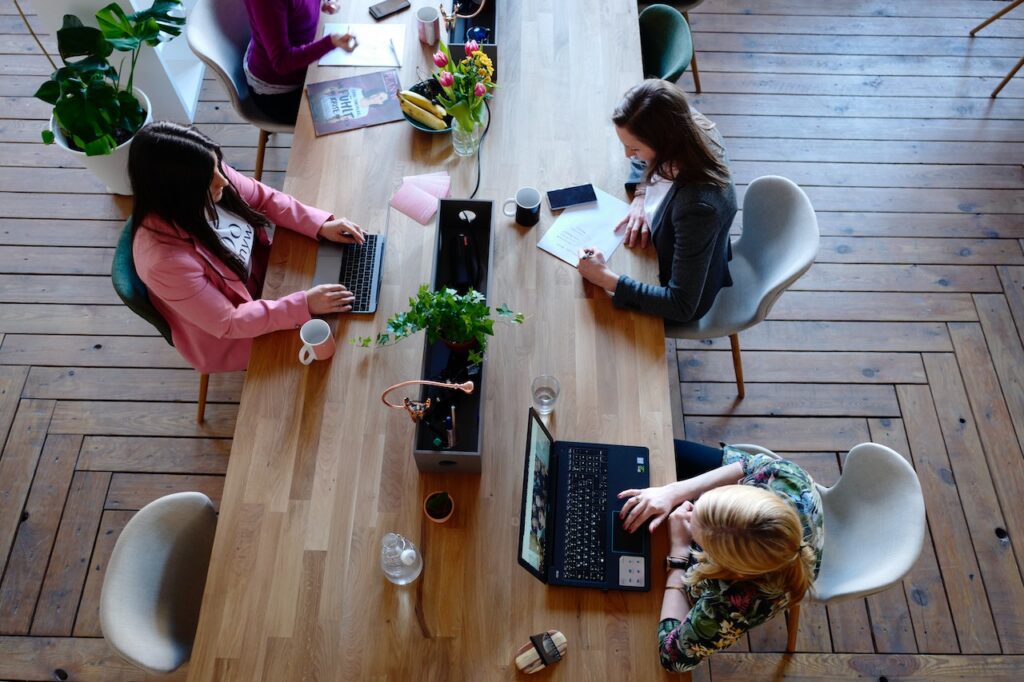As the year 2023 unfolds, the office landscape in London is narrating a tale of resurgence and transformation. The early subdued anticipations gave way to an upswing in activity within the Central London office market. When we delve into the statistics, a riveting narrative comes to light: the active office space requirements in Central London have climbed to 9.7 million square feet, marking a noteworthy ascent of 10% over the decade-long average. This uptick in demand isn’t merely a statistic; it embodies the city’s enduring spirit to adapt and flourish amidst evolving workplace paradigms.
This surge in office demand heralds a broader narrative, intertwining with the modern design innovations making their way into the corporate sphere. The essence of this transformation resonates with the broader ambition of organisations to create workspaces that are not just functional but are conducive to fostering creativity, collaboration, and employee well-being.

The Remote Work Conundrum: The Office as a Respite
The romanticisation of remote work, once heralded as the zenith of work-life equilibrium has gradually unveiled its own set of challenges. A recent survey discloses that 40% of individuals struggle to disengage from work while at home, and an alarming 48% admit to logging in longer hours when working remotely. Herein, the physical office re-emerges as a sanctuary, carving a clear demarcation between professional engagements and personal serenity.
Furthermore, the narrative of isolation among young employees is growing louder, with 81% articulating feelings of loneliness in the absence of office interactions. The physical workspace hence transforms into a social nexus, mitigating the solitude synonymous with remote work. This rekindled affinity towards physical offices underscores the imperative to craft workspaces that not only resonate with functional efficacy but also engender a sense of community and engagement among the workforce.
The Biophilic Design Wave: A Green Shift
The evolving office design ethos is gradually embracing biophilic elements, fostering a more organic and invigorating work environment. A Finnish indoor nature technology enterprise, Naava, embarked on a pilot study to scrutinise the impact of biophilic design on cognitive performance. The experiment entailed a cohort of 12 participants undertaking hand-written, cognitive word association tests across two disparate settings over two days. One setting was adorned with biophilic, air-purifying green walls, whilst the other was devoid of any plant life. The results were compelling; participants committed an average of 28 mistakes in the plant-less room, a figure that plummeted to 12 mistakes in the green-walled environment.
This experiment sheds light on the profound impact of biophilic design in enhancing cognitive acuity and creating a more conducive workspace. The inclusion of natural elements within the office doesn’t merely serve an aesthetic purpose; it’s a strategic endeavour to bolster employee well-being and productivity. By integrating elements of nature into the workspace, organisations are not only elevating the aesthetic appeal but are also making a pronounced statement about their commitment to fostering a holistic and health-centric work environment.
Sustainability at the Forefront: An Ethical Work Culture
The conversation around sustainability has transcended beyond mere buzzwords into actionable corporate ethos. A recent survey orchestrated by Skillsfirst unravelled that a significant half of the 135 respondents affirmed that a company’s sustainability practices would significantly influence their decision to work for them. This statistic is a clarion call for organisations to embed sustainability at the core of their operational and cultural blueprint.
The ripple effect of a sustainable work culture is manifold. It not only resonates with the ethical compass of the employees but also manifests as a tangible competitive advantage in the market. An eco-conscious workspace, underpinned by sustainable practices, is fast becoming a hallmark of modern, forward-thinking organisations. The transition towards a more sustainable work environment is not a mere shift in aesthetics or operations; it’s a profound statement of a company’s ethos and a reflection of its broader societal and environmental responsibility.
Embracing Employee-centric Workspaces: A Paradigm Shift
The evolution of workspaces is intrinsically linked to the overarching shift towards an employee-centric culture within organisations. In this new paradigm, fostering a culture of open communication, creativity, and empowerment is paramount. The very essence of an employee-centric workplace is about nurturing a conducive environment where staff feel secure to voice their ideas, question existing processes, and contribute towards innovative solutions.
A culture that encourages open dialogue and values employee input creates a ripple effect through the organisation, culminating in a more engaged, industrious, and satisfied workforce. This shift towards employee-centricity is more than just a cultural transformation; it’s a strategic move aimed at unlocking the immense potential and creativity inherent within a diverse workforce. By nurturing a culture that values each employee’s unique contributions, organisations are laying a robust foundation for sustained innovation and growth.
Modern Office Furniture: A Catalyst for Enhanced Productivity
The narrative of modern office furniture is not just about aesthetics or comfort; it’s a critical component in creating a workspace that inspires and facilitates productivity. The ergonomics of modern office furniture sourced from places such as Furnify plays a pivotal role in ensuring the physical well-being of employees, thereby directly impacting their efficiency and output. Furniture that is designed with the user’s comfort and health in mind can significantly reduce the occurrence of work-related ailments like back pain or carpal tunnel syndrome.
Furthermore, the design and layout of office furniture can significantly influence the overall ambiance and functionality of the workspace. For instance, furniture that facilitates easy movement and interaction can foster a more collaborative environment. Moreover, the aesthetics of modern office furniture can also play a significant role in creating a workspace that employees find inspiring and enjoyable. Sarah Syson, Head of Design at Claremont, succinctly encapsulates this sentiment, stating, “Now, the office needs to give employees the feelings and experiences that lone working leaves us wanting – those rich in face-to-face contact, collaboration and socialisation.” The strategic integration of modern office furniture is, therefore, a crucial step towards creating workspaces that are not only functional but also nurturing and inspiring.
The Workplace Well-being Agenda: More Than Just a Buzzword
The ethos of employee well-being has transitioned from being a mere corporate buzzword to a pivotal agenda within modern workspaces. The conceptualisation of well-being extends beyond physical health, enveloping the mental and emotional wellness of employees. A simple yet profound initiative in this domain is the creation of mindfulness meditation spaces within the office premises. Transmuting an erstwhile meeting room into a serene meditation zone provides employees with a tranquil refuge amid the bustling work environment. This dedicated quiet zone becomes a sanctuary where employees can retreat, re-centre, and rejuvenate, thus ameliorating the risks of burnout.
Moreover, incorporating well-being into the design and ethos of a workspace is a testament to an organisation’s commitment towards nurturing a holistically healthy and engaged workforce. This proactive approach towards employee well-being not only elevates the morale and productivity but also significantly contributes towards fostering a positive organisational culture. The ripple effects of a well-being centric workspace are profound, manifesting in enhanced employee satisfaction, reduced attrition rates, and an overall positive work environment.
Inspiring Innovation: The Office as a Canvas
The narrative of inspiring innovation within the workspace is closely tied to the physical and aesthetic aspects of the office environment. A recent survey from Claremont unveiled a concerning statistic – a significant proportion of British workers, encompassing 52% of hybrid workers and 48% of full-time office-based employees, find their workspaces lacking in inspiration and innovation. Further, 42% of respondents felt their office environment didn’t make them feel valued, underscoring the imperative for creating workspaces that inspire and invigorate.
The survey also highlighted an evolving expectation among employees; a whopping 84% now expect the office to deliver an experience, rather than merely being a place to complete tasks. This shift in perception underscores the importance of creating an office environment that is not just functional but also inspiring. The physical workspace becomes a canvas that can either foster or stifle creativity and innovation. By meticulously designing workspaces that spark creativity, facilitate interaction, and resonate with the organisational ethos, companies are not just enhancing productivity but also nurturing a culture of innovation and engagement.
Conclusion: The Nexus of Demand, Design, and Diligence
The burgeoning demand for office spaces in London is not a mere ephemeral trend, but a robust testament to the dynamic evolution of work culture. The year 2023 has ushered in a narrative of resurgence, pivoting around modern design innovations that transcend the traditional notions of a workspace. This transformation is deeply rooted in a holistic approach, intertwining the physical, aesthetic, and ethical dimensions of the workplace.
The discourse around modern office furniture, biophilic design, sustainability, employee-centric cultures, and well-being is not just about creating aesthetically pleasing workspaces. It’s a conscientious effort towards constructing environments that nurture the human spirit, foster creativity, and facilitate meaningful interactions. These elements are quintessential in addressing the modern-day challenges of remote working, employee engagement, and well-being.
The insights from industry experts and the compelling statistics underscore a profound shift in organisational priorities. The emphasis is now on creating workspaces that are not merely functional but are emblematic of a company’s ethos, values, and its unwavering commitment towards its employees’ holistic well-being.
As we navigate the contours of this new workspace paradigm, the synthesis of modern design innovations with a human-centric approach emerges as the linchpin for fostering a productive, satisfying, and inspiring work environment. The journey towards creating such transformative workspaces is a collaborative endeavour, necessitating a blend of innovative design, strategic foresight, and a deep understanding of the human experience within the workspace.
The resonance of this transformation within London’s office landscape is a beacon of what’s possible when meticulous design meets a forward-thinking, employee-centric ethos. It’s an exciting juncture in the evolving narrative of workspaces, with London spearheading a movement that is likely to resonate across the global corporate tapestry.

